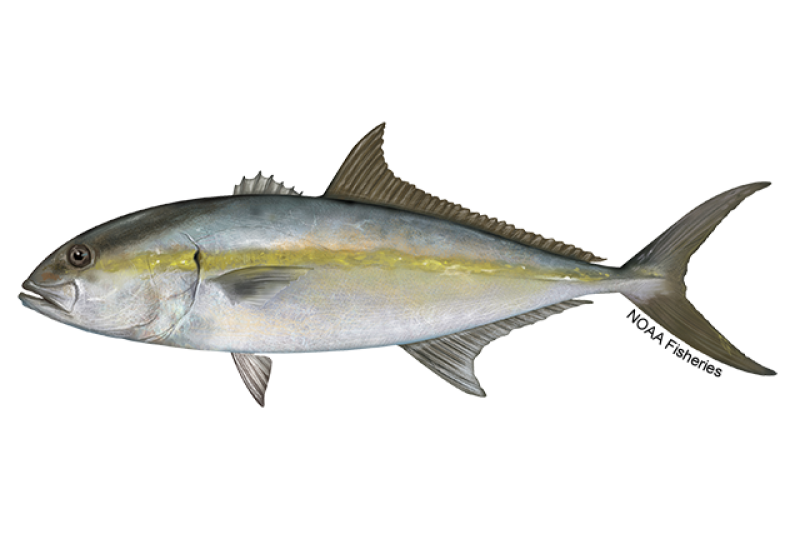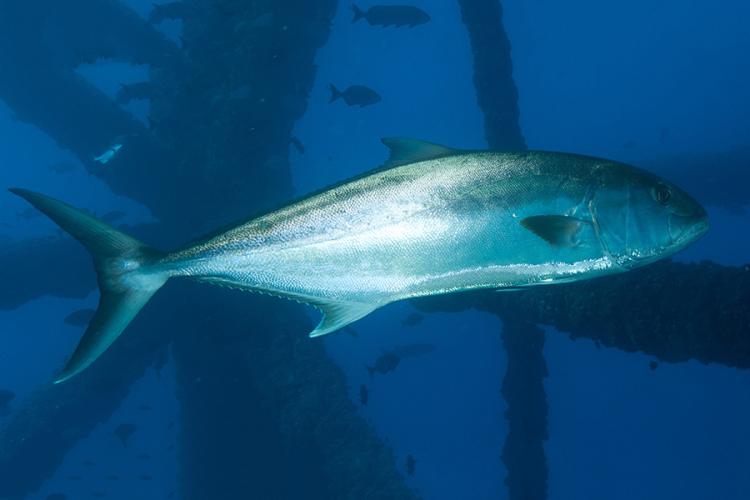 Greater amberjack. Credit: NOAA Fisheries
Greater amberjack. Credit: NOAA Fisheries
Greater amberjack. Credit: NOAA Fisheries
About the Species
 Greater amberjack. Credit: NOAA Fisheries
Greater amberjack. Credit: NOAA Fisheries
Greater amberjack. Credit: NOAA Fisheries
Although some populations are below target levels, U.S. wild-caught greater amberjack is still a smart seafood choice because it is sustainably managed and responsibly harvested under U.S. regulations.

Population
In the South Atlantic, the stock is not overfished. In the Gulf of America (formerly Gulf of Mexico), the stock is overfished, but the fishing rate established under a rebuilding plan promotes population growth.

Fishing Rate
In the South Atlantic, not subject to overfishing. In the Gulf of America, reduced to end overfishing.

Habitat Impact
Fishing gear used to catch greater amberjack rarely contacts the ocean floor and has minimal impacts on habitat.

Bycatch
Bycatch is low because the gears used to catch greater amberjack are selective.
Population Status
- There are two stocks of greater amberjack: a Gulf of Mexico stock and a South Atlantic stock. According to the most recent stock assessments:
- The Gulf of Mexico stock is overfished and subject to overfishing (2021 stock assessment). Summary stock assessment information can be found on Stock SMART.
- The South Atlantic stock is not overfished (2020 stock assessment) and not subject to overfishing based on 2022 catch data. Summary stock assessment information can be found on Stock SMART.
- During the period of high landings in the 1980s and 1990s, greater amberjack became an important alternative for red drum, which experienced decreases in commercial landings. In the Gulf of America, fishing rates were too high and the stock was declared overfished in 2001.
Appearance
- Greater amberjack have a dark amber strip on their head, extending from their nose to their first dorsal (back) fin, which becomes more defined when the fish is excited or feeding.
- They have a brownish or bluish-grey back, a silvery-white belly, and an amber horizontal strip along the middle of their body.
- Juveniles have a yellow color and five or six dark vertical bars along the sides.
Biology
- Greater amberjack can grow up to 6 feet long and live to be 17 years old.
- Adults can weigh up to 200 pounds, but are most commonly found to be up to 40 pounds.
- Females grow larger in size and live longer than males.
- Greater amberjack mature at about 3 to 4 years of age and spawn primarily from March to June on reefs and shipwrecks. A female can release between 18 and 59 million eggs during a single spawning season.
- Adults eat mostly crab, squid, and other fishes found on reefs.
- Juveniles feed on plankton, including crustacean larvae and other small invertebrates.
- Predators include seabirds and larger fishes, such as yellowfin tuna.
Where They Live
Range
- Greater amberjack are found in the Atlantic and Pacific Oceans.
- In the western Atlantic, they are found from Nova Scotia to Brazil, including the Gulf of America and the Caribbean.
Habitat
- Juvenile greater amberjack school around mats of pelagic (open ocean) Sargassum in the Gulf of America. Sargassum is an algae that provides food and protection for juvenile fish and invertebrates in the open ocean. Schooling behavior decreases as greater amberjack mature.
- They shift from inhabiting pelagic to demersal (near the ocean bottom) habitats at about 5 to 6 months of age. Sub-adults and adults congregate around reefs, rocky outcrops, and wrecks at depths of 60 to 240 feet.
- Some populations live in a particular location while others migrate, likely using a variety of habitats and areas throughout the year.
Fishery Management
- NOAA Fisheries and the South Atlantic, and Gulf of Mexico Fishery Management Councils manage the greater amberjack fishery.
- In the South Atlantic, managed under the Snapper-Grouper Fishery Management Plan:
- Fishermen must have a limited access snapper grouper permit to commercially harvest greater amberjack. Anyone entering the commercial fishery must buy two transferable vessel permits in order to qualify for a newly issued permit, thus eliminating one permit each time a new person enters the commercial fishery.
- Commercial and recreational size limits, to ensure that fish grow large enough to reproduce.
- Commercial trip and recreational bag limits.
- During April of each year, the commercial fishing season is closed to alleviate fishing pressure when the fish aggregate to spawn and are highly vulnerable to fishing. The sale and purchase of greater amberjack during this seasonal closure is illegal.
- To help protect deep-water snapper grouper species and their habitats, there are restrictions on the use of bottom longline and trawl fishing gear.
- There are eight deep-water marine protected areas intended to protect habitats.
- In the Gulf of America, managed under the Reef Fish Resources of the Gulf of Mexico Fishery Management Plan:
- Commercial and recreational size limits ensure that fish grow large enough to reproduce.
- Commercial and recreational trip and bag limits.
- To promote spawning and slow the rate of harvest, closed seasons have been implemented for the commercial (from March 1 through May 31) and recreational (from June 1 through July 31) fisheries.
- To help protect reef fish, sea turtles, and bottom habitat, there are restrictions on the use of longline gear.
- A rebuilding plan to rebuild the stock to the target population level is in place with a target date of 2028.
Harvest
- In 2023, commercial landings of greater amberjack totaled 600,000 pounds and were valued at approximately $1.3 million, according to the NOAA Fisheries commercial fishing landings database.
- Electric and hydraulic reels and hand lines are used to catch most of the commercial harvest of greater amberjack. Recreational harvest is by hook-and-line.
- Greater amberjack are large trophy fish prized by anglers.
- In 2023, recreational anglers landed 1.4 million pounds of greater amberjack, according to the NOAA Fisheries recreational fishing landings database.
Scientific Classification
- Greater amberjack are found in the Atlantic and Pacific Oceans.
- In the western Atlantic, they are found from Nova Scotia to Brazil, including the Gulf of America and the Caribbean.
- Juvenile greater amberjack school around mats of pelagic (open ocean) Sargassum in the Gulf of America. Sargassum is an algae that provides food and protection for juvenile fish and invertebrates in the open ocean. Schooling behavior decreases as greater amberjack mature.
- They shift from inhabiting pelagic to demersal (near the ocean bottom) habitats at about 5 to 6 months of age. Sub-adults and adults congregate around reefs, rocky outcrops, and wrecks at depths of 60 to 240 feet.
- Some populations live in a particular location while others migrate, likely using a variety of habitats and areas throughout the year.
Fishery Management
- NOAA Fisheries and the South Atlantic, and Gulf of Mexico Fishery Management Councils manage the greater amberjack fishery.
- In the South Atlantic, managed under the Snapper-Grouper Fishery Management Plan:
- Fishermen must have a limited access snapper grouper permit to commercially harvest greater amberjack. Anyone entering the commercial fishery must buy two transferable vessel permits in order to qualify for a newly issued permit, thus eliminating one permit each time a new person enters the commercial fishery.
- Commercial and recreational size limits, to ensure that fish grow large enough to reproduce.
- Commercial trip and recreational bag limits.
- During April of each year, the commercial fishing season is closed to alleviate fishing pressure when the fish aggregate to spawn and are highly vulnerable to fishing. The sale and purchase of greater amberjack during this seasonal closure is illegal.
- To help protect deep-water snapper grouper species and their habitats, there are restrictions on the use of bottom longline and trawl fishing gear.
- There are eight deep-water marine protected areas intended to protect habitats.
- In the Gulf of America, managed under the Reef Fish Resources of the Gulf of Mexico Fishery Management Plan:
- Commercial and recreational size limits ensure that fish grow large enough to reproduce.
- Commercial and recreational trip and bag limits.
- To promote spawning and slow the rate of harvest, closed seasons have been implemented for the commercial (from March 1 through May 31) and recreational (from June 1 through July 31) fisheries.
- To help protect reef fish, sea turtles, and bottom habitat, there are restrictions on the use of longline gear.
- A rebuilding plan to rebuild the stock to the target population level is in place with a target date of 2028.
Harvest
- In 2023, commercial landings of greater amberjack totaled 600,000 pounds and were valued at approximately $1.3 million, according to the NOAA Fisheries commercial fishing landings database.
- Electric and hydraulic reels and hand lines are used to catch most of the commercial harvest of greater amberjack. Recreational harvest is by hook-and-line.
- Greater amberjack are large trophy fish prized by anglers.
- In 2023, recreational anglers landed 1.4 million pounds of greater amberjack, according to the NOAA Fisheries recreational fishing landings database.
Scientific Classification
| Kingdom | Animalia | Phylum | Chordata | Class | Actinopterygii | Order | Carangiformes | Family | Carangidae | Genus | Seriola | Species | dumerili |
|---|
Last updated by NOAA Fisheries on 06/23/2025
Featured News
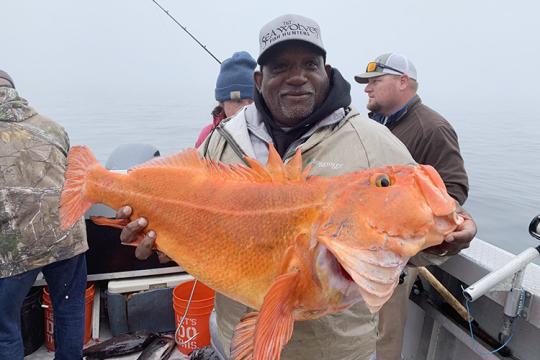
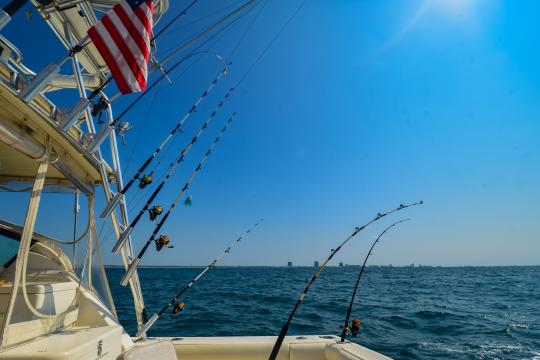 Saltwater fishing boat with poles in the Gulf of Mexico near Alabama.
Saltwater fishing boat with poles in the Gulf of Mexico near Alabama.
Shark Depredation: A Frustrating Experience for Fishermen in the Atlantic
 Juvenile coho salmon. Credit: iStock
Juvenile coho salmon. Credit: iStock
NOAA Fisheries Releases 2023 Status of Stocks
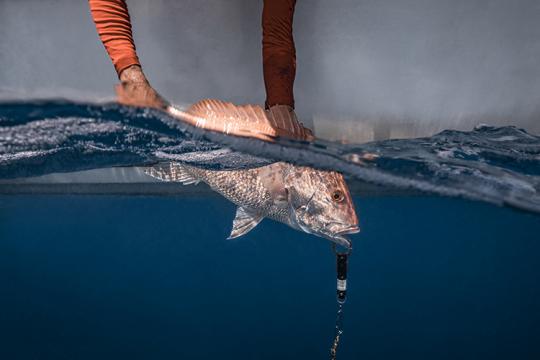
Seafood Facts

Is Greater Amberjack Sustainable?
Although some populations are below target levels, U.S. wild-caught greater amberjack is still a smart seafood choice because it is sustainably managed and responsibly harvested under U.S. regulations.
Availability
Fresh (except in April when fishery is closed) and frozen year-round.
Source
U.S. wild-caught from Virginia to Texas, including the U.S. Caribbean.
Taste
Greater amberjack has a sweet, mild flavor.
Texture
Tender, firm, and delicate. The high oil content gives it a buttery texture.
Nutrition Facts
Servings: 1; Serving Weight: 100 g; Calories: 146; Protein: 23.1 g; Total Fat: 5.24 g; Total Saturated Fatty Acids: 1.28 g; Carbohydrate: 0 g; Total Sugars: 0 g; Total Dietary Fiber: 0 g; Cholesterol: 55 mg; Selenium: 36.5 mcg; Sodium: 39 mgMore Information
Last updated by NOAA Fisheries on 06/23/2025
Seafood News
 Celebrate Culinary Arts Month with a sustainable seafood recipe for every month of the year.
Celebrate Culinary Arts Month with a sustainable seafood recipe for every month of the year.
What Your Birth Month Says About Your Next Seafood Recipe
 Fresh-caught taʻape on ice. Credit: Conservation International Hawaiʻi.
Fresh-caught taʻape on ice. Credit: Conservation International Hawaiʻi.
Reducing Waste and Feeding Communities in Hawaiʻi with a Whole Fish Approach
 Chef Tyler Hadfield’s Curried Skate Wings with Tomato-Masala Chutney
Chef Tyler Hadfield’s Curried Skate Wings with Tomato-Masala Chutney
Ring In the New Year With These Crowd-Favorite Seafood Recipes
 NOAA Fisheries, in collaboration with Blue Ocean Mariculture, is conducting a multi-year pilot study to evaluate observational methods and tools for studying Hawaiian monk seal behavior. Courtesy of Blue Ocean Mariculture
NOAA Fisheries, in collaboration with Blue Ocean Mariculture, is conducting a multi-year pilot study to evaluate observational methods and tools for studying Hawaiian monk seal behavior. Courtesy of Blue Ocean Mariculture
AI Meets Aquaculture to Study Hawaiian Monk Seal Interactions With Net Pens
Documents
Southeast Otter Trawl and Reef Fish Fisheries Observer Materials
For the Characterization of the U.S. Gulf of Mexico and Southeastern Atlantic Otter Trawl and…
Economics of the Gulf of Mexico Reef Fish Fishery – 2015
ELIZABETH OVERSTREET AND CHRISTOPHER LIESE
Economics of the Gulf of Mexico Reef Fish Fishery – 2016
ELIZABETH OVERSTREET AND CHRISTOPHER LIESE
Data & Maps
Outreach & Education
Approved Models and Equipment for Careful Release of Sea Turtles Caught in Gulf of Mexico Reef Fish Fishery and South Atlantic Snapper Grouper Fishery
Information to help fishermen comply with sea turtle release requirements contained in regulations…
Frequent Questions: Landing Federally-Managed Reef Fish Commercially Harvested from Gulf of Mexico Federal Waters
Last Updated: March 2019
Last updated by NOAA Fisheries on 06/23/2025
